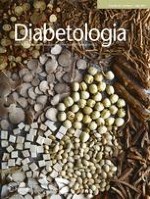Published in:

01-07-2011 | Article
Glucokinase mediates coupling of glycolysis to mitochondrial metabolism but not to beta cell damage at high glucose exposure levels
Authors:
H. Schmitt, S. Lenzen, S. Baltrusch
Published in:
Diabetologia
|
Issue 7/2011
Login to get access
Abstract
Aims/hypothesis
Glucose is the main stimulus of insulin secretion in pancreatic beta cells. However, high glucose has also been considered to damage beta cells. In this study we examined, with special emphasis on the role of the glucose sensor enzyme glucokinase, whether elevated glucose metabolism evokes toxicity to beta cells.
Methods
RINm5F-R-EYFP-GK cells, producing glucokinase in response to a synthetic inducer, and rat beta cells were incubated at different glucose concentrations. Glucokinase enzyme activity, insulin secretion, cell viability and mitochondrial metabolism were analysed.
Results
Glucokinase production evoked a concentration-dependent increase in glucose-induced insulin secretion from RINm5F-R-EYFP-GK cells without reducing cell viability. Pre-culture at high glucose (30 mmol/l) in the absence of high concentrations of NEFA neither reduced viability nor significantly increased apoptosis in RINm5F-R-EYFP-GK cells and rat beta cells. The integrity of the mitochondrial respiratory chain and mitochondrial dynamics, namely fusion and fission, were not impaired by high glucose pre-culture. As previously demonstrated in mouse beta cells, pre-culture at high glucose significantly decreased the mitochondrial membrane potential heterogeneity in RINm5F-R-EYFP-GK cells. Indeed, after starvation, in response to glucose, rat beta cells and RINm5F-R-EYFP-GK cells with glucokinase production pre-cultured for 48 h at high glucose showed the fastest increase in the mitochondrial membrane potential.
Conclusions/Interpretation
Our experiments do not support the hypothesis that glucokinase and the glucose metabolism on its own act as a mediator of beta cell toxicity. By contrast, rather a beneficial effect on glucose-induced insulin secretion after glucokinase production was observed, based on an improved coupling of the glucose stimulus to the mitochondrial metabolism.